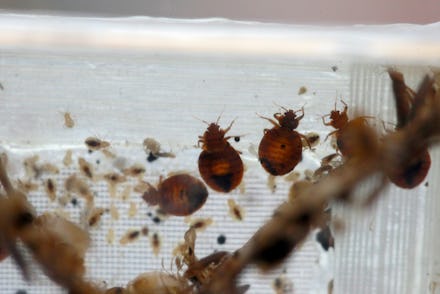Holy Sh*t: Bedbugs Just Turned Into Super-Bedbugs That Are Resistant to Chemicals

What's the one thing worse than having bedbugs? An infestation of super-bedbugs that are physically impossible to kill.
It may sound like the stuff of nightmares, but it soon could be a reality. Bedbugs in the U.S. have developed a "dramatic" resistance to a type of chemical commonly used to kill them, according to new research published in the Journal of Medical Entomology.
The troubling discovery "further limits the options for chemical control of bedbugs," the researchers wrote.
The chemicals are known as neonicotinoids — one of the seven families of chemicals most commonly used to kill bedbugs, according to the U.S. Environmental Protection Agency. A synthetic form of nicotine, neonicotinoids cause bedbugs' nerves to "fire continually until they fail."
To conduct their study, researchers examined four populations of bedbugs — some that had been collected recently, and other more susceptible populations that had spent years, or decades, in a lab. They exposed the critters to four neonicotinoids: acetamiprid, imidacloprid, dinotefuran and thiamethoxam.
The two most recently collected bedbug populations, from Cincinnati, Ohio, and Troy, Michigan, showed resistance to all of the chemicals — including a "dramatic" level of resistance to acetamiprid.
What, exactly, does "dramatic" resistance entail? Bedbugs that had been stored in a laboratory for 30 years suffered a 100% mortality rate when exposed to 10 nanograms of acetamiprid. But when the bedbugs from Ohio and Michigan were exposed to concentrations of acetamiprid 1,000 times stronger, only 28.3% and 26.7% of them died, respectively.
Even bedbugs collected in 2008 in Jersey City, which had spent five years in a lab, showed moderate resistance to the neonicotinoids acetamiprid and dinotefuran.
Why did the bedbugs become resistant? It's possibly because we've used so many neonicotinoid products to kill them in recent years. The bedbugs eventually develop mutations in their nicotine receptors, which makes it harder for the neonicotinoid compounds to bind to their targets, the researchers wrote.
It gets worse. According to past research, neonicotinoids aren't the only chemicals to which bedbugs have developed a resistance. According to the EPA, some bedbugs have also become resistant to the most common chemicals used to kill indoor pests.
So how do you make sure your bedbugs really die? The EPA recommends varying the chemicals you use to kill them.
In a 2013 study published in Scientific Reports, scientists compared the genes of 20 different U.S. bedbug populations to the genes of a susceptible population that had spent years in a lab. The bedbugs had multiple genetic means of resisting pyrethroids, they discovered.
So how do you make sure your bedbugs really die? The EPA recommends varying the chemicals you use to kill them. And if you don't want to get bedbugs in the first place, definitely don't stay at this NYC hotel.